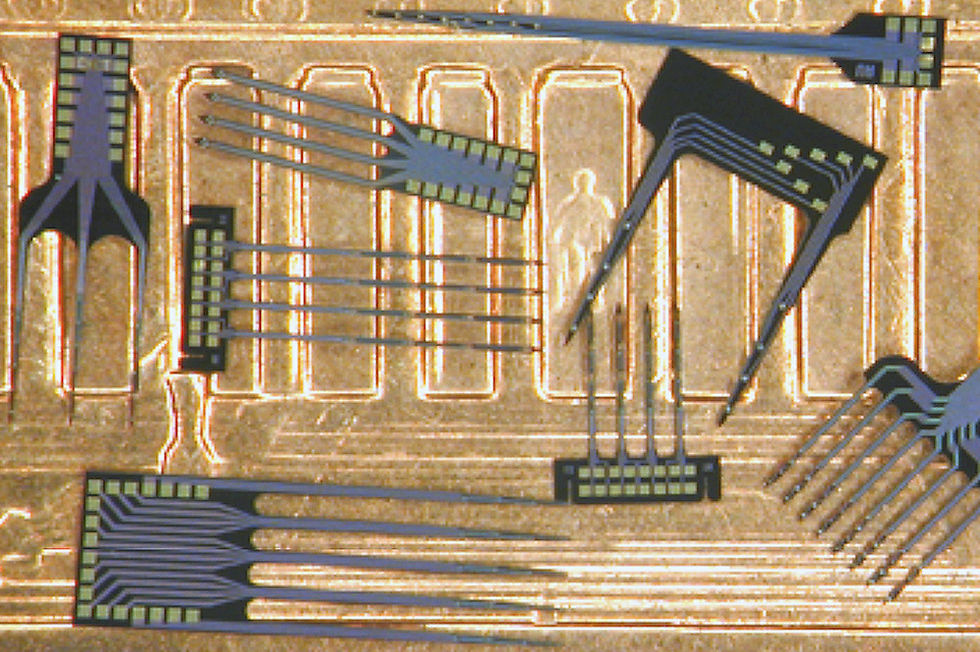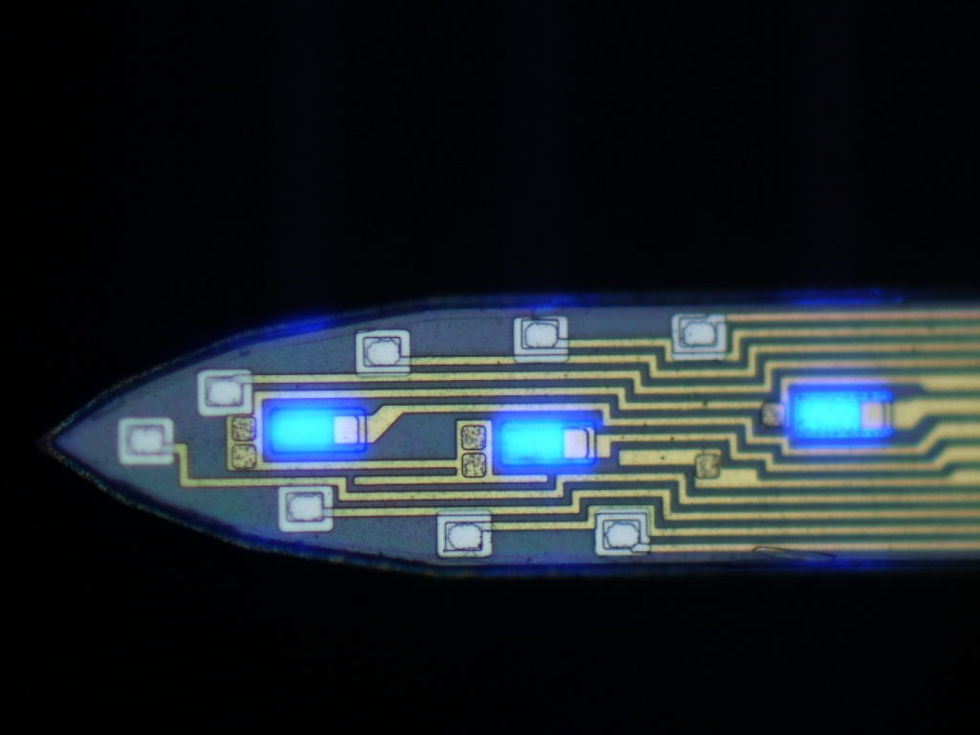【BCI】Very Popular in Medical Development— Invasive Brain-Computer Interface
- Kevin
- Nov 7, 2022
- 8 min read
Today, I would like to talk about invasive brain-computer interfaces, the types and some difficulties scientists face, and of course, some of my thoughts. Hope it is helpful for you to become more familiar with this field.
Types
Invasive brain-computer interfaces have many different types. In this post, I will introduce two types that are seen more frequently in the lab, and one type is usually used in medical settings.
Microelectrode array
According to U.S Food and Drug Administration (FDA), there is only one human implantable invasive brain-computer interface, which is the microelectrode array, also known as the Utah array.
It looks like this

Source
This is the schematic when it is / they are implanted

It is usually a 10×10 array, and there will be multiple electrodes on the array, which are thin as needles with diameters to be around 200~400 μm and lengths to be around 1~3mm. The neural signals will be brought up to the portal on the surface of the skull by the wires. Unfortunately, there will be 10% of the electrodes are not able to conduct the signals correctly because they are so thin and therefore brittle. We said that the neural signal has to be very close to the neurons in order to read the signal in the previous posts. Don’t think that is hard to achieve, according to the density of the neural cells in the brain, it is very easy to become that close. Each electrode is going to record a different neural signal and be sent to the portal, which is going to be screwed onto the human skull using bio-compatible screws and because the wires are pre-arranged, the signals from different neurons can be distinguished. Through some complicated algorithms, those signals can be used to control the machine. The demonstration video is down below:
The video is a bit long, so just watching one small section is enough, it’s cool! The woman in the video is actually paralyzed. She used her brain to operate a robotic arm to grab and feed herself chocolate. The device on the head is where the invasive interface is. Although we can see that the mechanical arm did not move as smoothly as the general arm, it is already very exciting to have the technology reaching such a state. Of course, this technology cannot be used as soon as it is implanted. It takes a long time to train users and make many improvements to the algorithm along with the training. Later on, they interviewed the lady and said, what were you thinking during the operation, the lady asked the interviewer, what were you thinking when you moved your hand, which means that the operation of this technology is already very intuitive.
But the disadvantages of this technology are also obvious. First, the signal will not be read due to inflammation in the first few days of implantation. After about two weeks, the signal will gradually be detected. There is going to be a three-month critical recovering period. During the three months, the signal will be very unstable, because the membrane between the brain and the skull is being repaired by the human body, and the direction of repair determines the success of this technology. If the membrane goes under the array and pushes it out, the implantation fails. If it grows on top of the array and presses it down, the array is stabilized, and the implantation success. Of course, the surgeon or scientist will use some materials to lead the direction of membrane repair. If the implementation is successful, it can last for about four years, and the quality of the signal is the best for the first year. After that, the quality of the signal is going to decrease until completely disappears. Therefore, although it feels that it is very powerful to use the brain to control the mechanical arm, for people without physical disabilities, the cost of this technology is too high, and the working period is too short.
Remember, currently, this is the only technology that can be installed in the human body certified by the US FDA, so all the videos you watch online that are operated by humans are probably using Utah Array! The place where the signal is recorded is also in the motor and sensory cortex, as mentioned earlier.
Michigan Probe
Looks like this:

Source
The zoomed-in image of the tips:

Source
It is composed of many wires, so one can record electrical signals in many different positions on the z-axis. Its advantage is that it can record deeper signals than Utah Array. However, I did not find many research papers about it, so I will just list them here.
Electrocorticography (ECoG)
It looks like this

Blausen.com staff (2014). “Medical gallery of Blausen Medical 2014&”. WikiJournal of Medicine 1 (2). DOI:10.15347/wjm/2014.010. ISSN 2002-4436.
It is often defined as semi-invasive, because it is, in fact, an electrode array patch attached to the surface of the brain. It can record brain activity more accurately than external monitoring, but the area it covers is larger than invasive methods. So, it is a compromise? But the frequency of its usage is actually not that high. First of all, it is not as accurate as the methods mentioned above, because it does not really touch the nerves but only on the surface of the brain. Also, it has no benefits that non-invasive techniques have because it still needs to open the skull. If it is just to increase a little bit of accuracy, it is too much of a loss, so the application range is very narrow. It may only be used by patients with epilepsy in some special cases.
Advantages of Invasive BCI
Before we talk about the disadvantages, let’s talk about some good aspects of it
The Signal is More Accurate
The brain is protected by the scalp and skull. They not only provide physical protection but also prevent internal signals from being transmitted. The advantage of the invasive method bypasses all those and can directly record from the signal source—the nerves, and obtain a very precise signal.
Less Noise
All nerves generate electrical signals and so do muscle nerves. Non-invasive electrodes are attached to the outside of the skull. The muscle signal of blinking or the muscle signal of stretching will directly overshadow the electrical signal in the brain. An invasive brain-computer interface apparently avoids these noises created by other muscle nerves
High Temporal Resolution
This may be a bit redundant to mention, but after seeing the non-invasive brain-computer interface, you may think this is a very important characteristic. The recorded electrical signals can immediately be translated to operate the machines. So the user can watch how the machine works while adjusting their own thoughts, this greatly improves the overall accuracy.
There are not many advantages I can think of, but these points are very important. If there are no disadvantages below, the invasive brain-computer interface will definitely become mainstream, because these advantages are too tempting, as long as they continue to develop, everyone will be able to use them.
Disadvantages of Invasive BCI
The brain is constantly changing
You may think that once the array was implanted, it can be used forever right? Wrong, the brain is a working organ which means that it changes all the time, especially the connections between the neurons. So far, we thought that the reason why we can remember and understand things is that the connections of the brain are always changing. You will be worried if the connections inside your brain are not changing, but the fact that it is always changing is a nightmare for invasive brain-computer interfaces. The electrodes inserted in the morning may have to be recalibrated in the afternoon. The electrodes inserted today may not get any signal tomorrow. You can think of those electrodes as a boat floating on the water. The nerves are like the fish below, although there is a lot of fish, it is very difficult to see the same fish all the time. And with the current technology, the calibration time can be very long. I don’t remember the exact number, but I remember it was about an hour. Think about it, after you install the device, it takes an hour to calibrate it every morning. I wouldn’t want to use it after a while, but it had been implanted and would require another surgery to take it out.
Immune System
No matter what kind of material is used on the surface of the electrodes, according to the current technology, the immune system will still sees the array as a foreign body. The place where the electrode is inserted will form scars due to the destruction of the tissue. After the scars were formed, the neurons will not grow in that location. Over time, the electrical signal will gradually disappear and cannot be recorded. This means it is not an everlasting implant, at least not with current technology. The implantation site will also have a chance to cause inflammation and infection. This is the human brain, no one knows how bad it can be. Moreover, experiments have confirmed that inflammation would cause chronic neurodegeneration, so the overall risk needs to be reassessed.
Limited Effective Time
Although all technologies have a time of use, for example, a mobile phone may only be used for two or three years; a computer may have to be replaced in four or five years; the implanted artificial heart seems to last for ten years. For a device that is implanted into the human brain, the lifespan of the current brain-computer interface is a bit too short. People bear so many risks in performing surgery and recovering, but it can only last for four years.
Small Region of Recording
Although the microelectrode array has more than 100 electrodes, compared to the whole brain, it is still a very small amount. As you can see, its coverage area is really small, smaller than a fingernail, there is no way you can understand the condition of the whole brain with such a small region. But this disadvantage seems to be okay, because it may be solved with more electrode arrays.
There are also some other disadvantages such as the high price. But I believe the disadvantages above are enough to keep people away from the invasive brain-computer interface. Although it has extremely precise control capabilities, there seems to be a long way to go for this technology to be used by the general public.
My Point of View
Personally, I am not particularly optimistic about the invasive brain-computer interface. On one hand, it is difficult to popularize it. Not everyone is willing to put electrodes into their brain. On the other hand, there are a lot of disadvantages mentioned above. This method is not a once-and-for-all method. In terms of current technology, it is very likely that it will eventually evolve into a piece of useless metal stuck inside the head. Although I partially agree with the view that the final development of BCI must be invasive. Because its accuracy is at another level compared with all non-invasive BCIs, but with current technology, there is still a long way to go. But don’t be discouraged, what I said here may not be necessarily correct, after all, there are so many laboratories in the world doing experiments. If we make breakthroughs in biomedical materials or make amazing discoveries in neuroscience, it is very likely that the invasive BCI becomes the biggest winner overnight.
There are fewer types of invasive brain-computer interfaces, so I will only spend one article on them. But that doesn’t mean it’s easier. The signal processing behind it is very complicated. We’ll talk about it later.
Please leave me a message to me if you have some thoughts or questions.






Comments